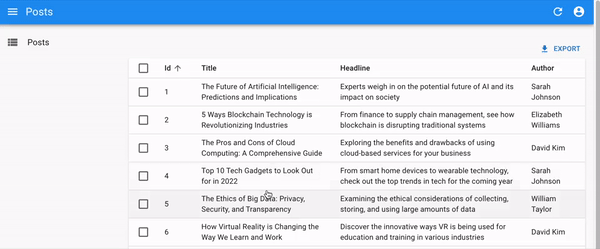useLockOnMount
This Enterprise Edition
useLockOnMount calls dataProvider.lock() on mount and dataProvider.unlock() on unmount to lock and unlock the record. It relies on authProvider.getIdentity() to get the identity of the current user. It guesses the current resource and recordId from the context (or the route) if not provided.

Usage
Use this hook e.g. in an <Edit> component to lock the record so that it only accepts updates from the current user.
import { Edit, SimpleForm, TextInput } from 'react-admin';
import { useLockOnMount } from '@react-admin/ra-realtime';
import { Alert, AlertTitle, Box } from '@material-ui/core';
const PostAside = () => {
const { isLocked, error, isLoading } = useLockOnMount();
return (
<Box width={200} ml={1}>
{isLoading && <Alert severity="info">Locking post...</Alert>}
{error && (
<Alert severity="warning">
<AlertTitle>Failed to lock</AlertTitle>Someone else is
probably already locking it.
</Alert>
)}
{isLocked && (
<Alert severity="success">
<AlertTitle>Post locked</AlertTitle> Only you can edit it.
</Alert>
)}
</Box>
);
};
const PostEdit = () => (
<Edit aside={<PostAside />}>
<SimpleForm>
<TextInput source="title" fullWidth />
<TextInput source="headline" fullWidth multiline />
<TextInput source="author" fullWidth />
</SimpleForm>
</Edit>
);
Parameters
useLockOnMount accepts a single options parameter, with the following properties (all optional):
identity: An identifier (string or number) corresponding to the identity of the locker (e.g.'julien'). This could be an authentication token for instance. Falls back to the identifier of the identity returned by theAuthProvider.getIdentity()function.resource: The resource name (e.g.'posts'). The hook uses theResourceContextif not provided.id: The record id (e.g.123). The hook uses theRecordContextif not provided.meta: An object that will be forwarded to thedataProvider.lock()calllockMutationOptions:react-querymutation options, used to customize the lock side-effects for instanceunlockMutationOptions:react-querymutation options, used to customize the unlock side-effects for instance
You can call useLockOnMount with no parameter, and it will guess the resource and record id from the context (or the route):
const { isLocked, error, isLoading } = useLockOnMount();
Or you can provide them explicitly:
const { isLocked, error, isLoading } = useLockOnMount({
resource: 'venues',
id: 123,
identity: 'John Doe',
});
Tip: If the record can’t be locked because another user is already locking it, you can use react-query’s retry feature to try again later:
const { isLocked, error, isLoading } = useLockOnMount({
lockMutationOptions: {
// retry every 5 seconds, until the lock is acquired
retry: true,
retryDelay: 5000,
},
});
